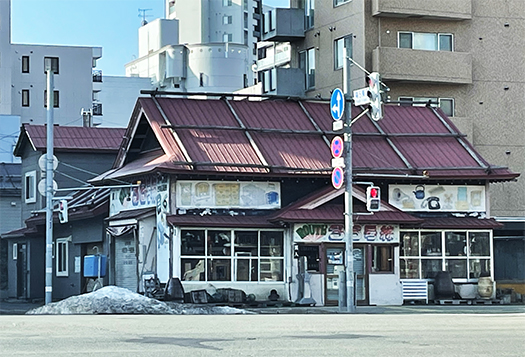
最近よく札幌市中心部をクルマで走っています。わたしがいま住んでいるのは札幌の最初期に近い「新興」住宅地。昭和、それも戦後期からのものですが比較的に新しい建物が多かったり、どんどん「手を加えている」更新された住宅が多い。一方で、原・札幌市とでも呼ぶべき札幌市中央区の市街地とはやや時代的に違いがある。
わたし自身は3才からの札幌市民で、原・札幌の景観にある種のノスタルジーを感じる世代。
で、写真のような木造建築がそのまま令和の現代まで生き延びている様子につい反応してしまう。「あ、街んなかの家だ」と懐かしがる自分がいるワケです。
この建物は街中のそれも目抜き通りに面した建物だけれど、いわゆる「繁華街」とは少し遠い立地。けれど角地なので非常に「目立つ」。屋根は入母屋で木製の「雪止め」が「これでもか」と時代感を見せてくれる。1階はほぼ全面的な開放間取りのようで、道路側面は出入り口も含めてすべてが窓・開口部になっている。窓枠を見るとどうも木製造作窓で単板硝子窓と見受けられる。たぶん最初から「店舗」用として建てられた建物に違いない。
現状有姿もまんま、店舗のように見受けられる。派手な出入り口上部看板などから想像できる。一見して「昭和レトロ」そのものなワケですが、これはこれでそういう「吸引力」を持っている。
わたしみたいな年代の人間とか、そういった趣味傾向を持った人には、ある雰囲気が伝わってくるのでしょう。そういう種類の商品店舗としては、独特のアピール力がある。ただしかなりマニアックに絞られるとは言えるでしょう。
札幌は200万都市であり、こういう特殊なマーケット層というのもけっこう厚めに存在すると思われる。それに似合ってしかも高付加価値の商品・サービスであれば、成立するかもと妄想をかき立てられる。ただし、小さいマーケットサイズを狙うとすれば遠隔地からの来客を狙っての駐車場設備が必須だろうから、その辺がネックになるかもしれない。中心街とはいえ、歩いてこの場所にたどりつくには交通ネットワークとの利便性がやや劣っている。さて、といったところでしょうか。
都市の魅力・吸引力というものにはこういう部分もあると思う。なにもかもが現代的な空間性に収まりきっていない、時間的なタイムスリップ感というのもあり得るのだと思う。
現代日本人にも「古民家」へのノスタルジーというものは存在する。消え去りつつあるものへの愛着というような部類のものだろうか。ただ「北海道開拓の村」に入れるにはちょっと早いか、というところ。まだ、明確に時代イメージが確定していないけれど、わたし的には北海道的「古民家」とも思える。いかがでしょうか?
English version
Showa-retro” atmospheric architecture of Sapporo city block.
Remnants of the original landscape architecture of Sapporo. The snow stops on the roofs, which are a showpiece of the area, convey a sense that traditional Japanese store architecture has “survived in Sapporo”.
Recently, I have been driving around the central part of Sapporo. I currently live in a “new” residential area near the beginning of Sapporo. There are many relatively new buildings and houses that have been updated and “modified” since the Showa period (postwar period). On the other hand, it is somewhat different from the urban area of Chuo-ku, Sapporo, which should be called the “original Sapporo City” in terms of time.
I myself have been a Sapporo resident since I was 3 years old, and I am of the generation that feels a certain nostalgia for the landscape of the original Sapporo.
I am of the generation that feels a certain nostalgia for the landscape of the original Sapporo, and I am struck by the fact that wooden buildings like the one in the photo have survived to the present day, in 2022. I find myself thinking nostalgically, “Ah, it’s a house in the city.
Although this building faces a main street in the city, it is located a little far from the so-called “downtown area. However, it stands out because of its corner location. The first floor seems to be almost entirely open, with windows and openings on all sides of the street, including the entrance. Looking at the window frames, it appears to be a wooden window with a single-pane glass window. The building was probably built as a “store” from the beginning.
The building as it is now looks just like a store. This can be imagined from the gaudy signboard above the entrance and exit. At first glance, the building looks very “Showa-era retro,” but it has its own kind of “attractiveness.
People of my age and those who have such tastes will probably be able to sense a certain atmosphere. It has a unique appeal for that kind of product store. However, it can be said that it is quite maniacally focused.
Sapporo is a city of 2 million people, and this particular market segment is also considered to be quite large. If the product or service is suitable for this market and has high added value, it may be feasible. However, if the market size is small, parking facilities would be necessary to accommodate visitors from remote areas, and this may be a bottleneck. Even though it is located in the center of the city, the transportation network is not convenient enough to reach this location on foot. Well, that’s about it.
I think this is part of the attraction of a city. I think it is also possible to have a sense of time slip, where everything is not fully contained in modern spatiality.
Nostalgia for “old private houses” exists even among modern Japanese. It may be a kind of attachment to something that is disappearing. However, I think it is a little early to include them in the “Hokkaido Kaitakushi no Mura” (Village of Hokkaido Settlement). Although the image of the period has not yet been clearly defined, to me it seems to be an “old house” in the Hokkaido style. What do you think?
Posted on 4月 8th, 2024 by 三木 奎吾
Filed under: 住宅マーケティング








コメントを投稿
「※誹謗中傷や、悪意のある書き込み、営利目的などのコメントを防ぐために、投稿された全てのコメントは一時的に保留されますのでご了承ください。」
You must be logged in to post a comment.